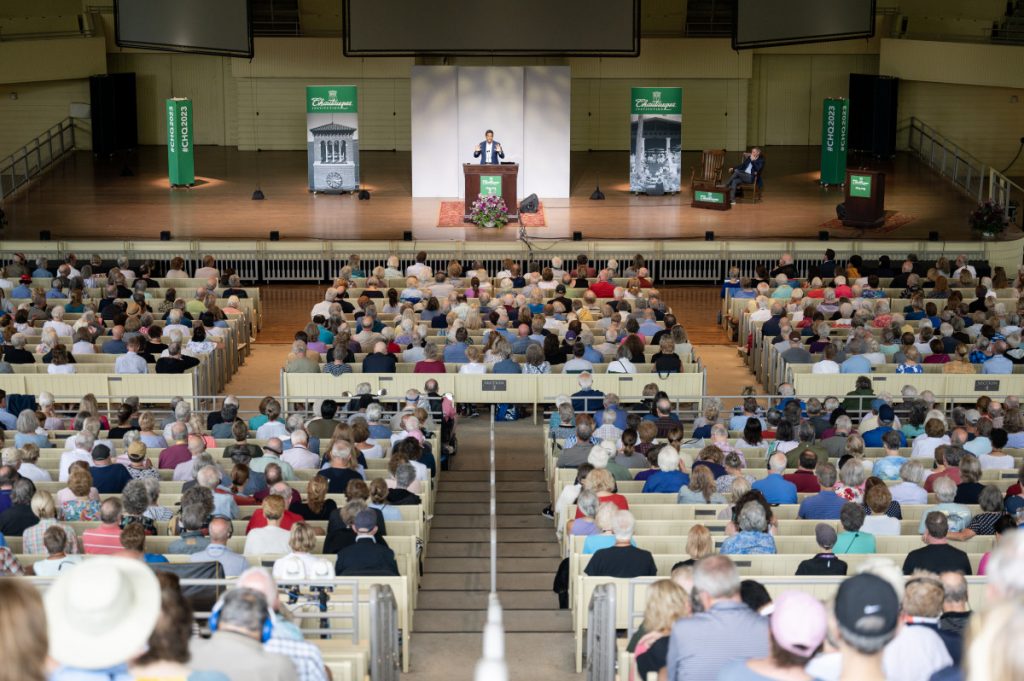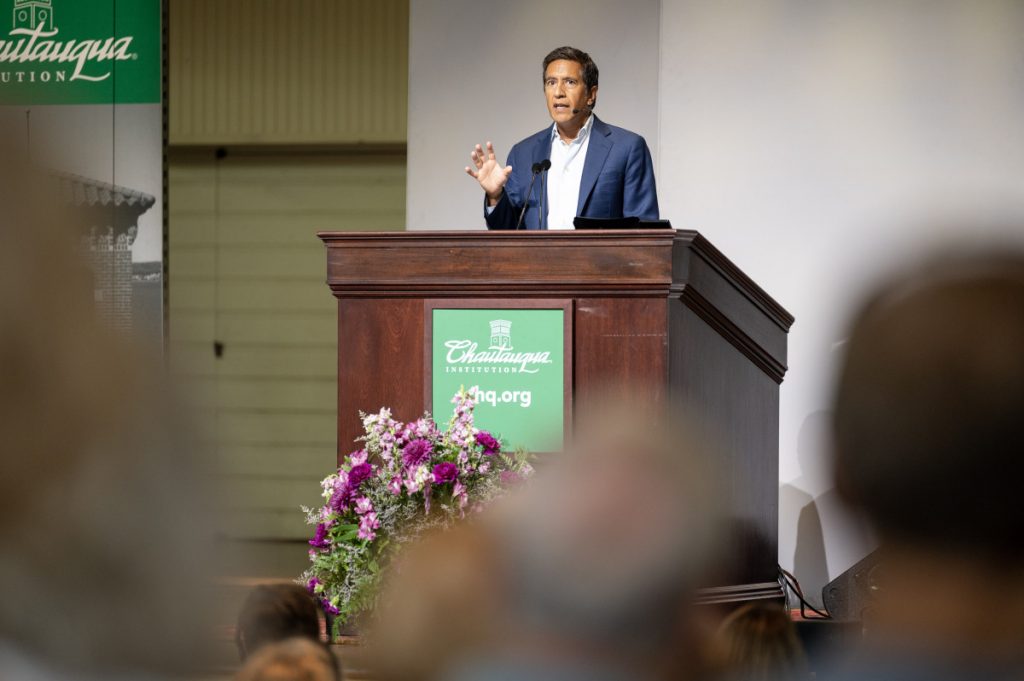
CNN Chief Medical Correspondent Dr. Sanjay Gupta took a journey in 2018 to a remote area of Bolivia in the Amazon rainforest in order to report on the Tsimane tribe.
The group had been identified in a medical journal as having the healthiest hearts in the world, and with a history in his family of heart disease — the leading cause of death in the United States — Gupta wanted to investigate if the Indigenous tribe’s lifestyle could help inform Americans on how to prevent it.
“Every demographic in the world now is affected by many of the same chronic diseases we’re dealing with in the United States, every demographic – but this particular tribe seems to be different,” he said. “All I wanted to do is observe and see what I could learn about the healthiest-hearted people in the world.”
Delivering the final morning lecture of the 2023 Summer Assembly Season, Gupta closed Week Nine for the Chautauqua Lecture Series at 10:45 a.m. Friday in the Amphitheater by discussing “Reporting and Practicing Medicine in the Global South.”
Working for CNN since 2001, Gupta is a practicing neurosurgeon, New York Times bestselling author, award-winning broadcast journalist and associate professor at Emory University Hospital.
“I’ve traveled to more than 100 countries, many of them in the Global South, and I realized … that health is a great big common denominator,” he said.
During his trip to Bolivia, Gupta said he focused on what he called the big three: activity, diet and rest.
First, he observed the tribe’s hunter-gatherer activity.
“Maybe you have a preconceived notion of what it’s like to be a hunter-gatherer in the middle of the Amazon rainforest,” he said. “They hardly ever run. They walk. A lot. When they’re hunting, they track their prey, they’re not trying to outrun their prey.”
Gupta found that members of the tribe walk about 17,000 steps per day on average, which is “a lot, but doable.”
Aside from walking, the Tsimane people don’t sit often.
“There are few chairs, as you might imagine, in the middle of the rainforest,” he said, explaining that sitting sends signals to the body that can lower its defenses “so suddenly you’re more susceptible to things.”
Second, when it comes to diet, Gupta found that instead of something akin to what Americans know as the “paleo” diet, high in protein, the Tsimane people’s diets were high in carbs.
“The vast majority of what the healthiest-hearted people eat is farmed food; it’s carbs, it’s plantains,” he said.
Last, for rest, he turned in to his tent at about 9:30 p.m. and rose with the sound of the roosters at 6:30 a.m., so the Tsimane sleep about nine hours every night.

He didn’t expect to find a fourth contributing factor, but realized the Tsimane frequently deal with parasitic infections early in life that result in boosted immune systems.
“Most of the diseases we talk about — heart disease, diabetes, dementia — have some component of our own immune system either igniting or worsening those diseases,” he said. “Our immune systems — which we live in these incredible bubbles of cleanliness — oftentimes start to get bored,” he said. “If you have a parasite in your body, you may be giving your immune system something to do and decreasing the likelihood of developing those autoimmune diseases.”
Gupta said rather than relying on the newest, most expensive medical innovations, in order to prevent heart disease, there is still more to learn from the health practices of the Tsimane.
“It’s worth paying attention to, engaging in the basics, trying to understand those basics, things that have withstood the test of time,” he said.
In examining this and other topics in his role with CNN, Gupta said medical developments have to be considered with the complexities of people in mind.
“We’ve got to remember as we continue to innovate, the real value of human connection, whether it be in medicine or in media,” he said.
With a background first as a doctor, he came to the world of journalism wanting to be a “policy wonk,” examining the efficiency and effectiveness of healthcare systems.
As a medical journalist, he and his colleagues “tackle the issues we think matter the most, have really broad relevance, things you can incorporate into your own lives and have big meaning across society,” he said.
This is why he decided to explore life expectancy — what he called “one of the markers of how we measure how well a healthcare system works” — for an HBO documentary, “One Nation Under Stress,” in 2019.
When reviewing every demographic in the developed world since World War II, he found that all have increased in life expectancy except the white working-class in the United States, Gupta said.
In that group, the top three causes of premature death are: liver cirrhosis due to alcoholism, suicide and drug overdoses, typically due to opioids. Researchers called these “deaths of despair,” Gupta said.
The increased frequency of these causes of death was so significant that the life expectancy for all populations in the United States dropped, he said.
Offspring of the Greatest Generation were supposed interhit a better country, Gupta said. “Expectations were dashed and that is a very toxic thing.”
Other research he examined had uncovered that extreme inequality is bad for health outcomes, for both the rich and the poor, the “have” and the “have not.”
In the documentary, he had researchers reenact an experiment using rewards for two Capuchin monkeys who were able to see each other in glass cages.
A monkey on the left was taught to give a rock to the examiner in exchange for a piece of cucumber over and over. Then, the same exchange took place with a monkey on the right, but instead of cucumber, it received grapes.
Returning to the monkey on the left, it got angry, now expecting grapes instead of cucumber.
“Stress levels for the monkey on the left were through the roof, no surprise,” Gupta said. “But the stress levels for the monkey on the right, also going through the roof.”
The degree of inequality in the United States is the highest in the developed world, he said.
“It’s emblematic of a story that we need to be mindful of,” Gupta said. “It’s the story of a problem, but in many ways it’s also the story of a solution: an opportunity to better, once you understand what is really happening.”
Using stories to share information, teach lessons and solve problems have always been essential for human beings, but the way people tell those stories matter, Gupta said.
“The problem I find increasingly when you watch and consume content is that there’s a lot of stories that basically default to the use of fear as a motivation,” he said. “When it comes to health, the message might be you will get heart disease if you eat this, you will get cancer, you will die young. It’s scary.”
Motivating people with fear, however, doesn’t last long since these appeals activate the amygdala in the brain, the emotional center, Gupta said, but it bypasses executive function.
“It becomes action without a plan, it is jumbled and disorganized and it doesn’t lead to anything permanent,” he said.
Instead, with his work, Gupta said he focuses on hope and the “what and the why” of enduring purpose.
“People are reminded … that no matter where they are today — whether they just won a race or they are in the depths of chronic disease — that they can be better tomorrow,” he said. “In many ways, we haven’t even begun to try because we oftentimes are resorting to these fear-based messaging.”
During his more than 20-year career, lessons of hope have often come from the Global South, Gupta said.
With his reporting, Gupta and his colleagues are “constantly balancing the inflection between hope and honesty,” he said, but one is not the opposite of the other.
“Hope can help heal,” he said.
When sent to report stories in places of conflict, Gupta said he has also come to find that no matter where he travels, no matter the circumstances, meaningful human connections can form.
“Many people may not be able to identify Aleppo on a map, but if I start to tell you the stories of the people who live there, their lives don’t sound too different from yours,” he said. “They lived their lives, then one day, bombs started falling out of the sky.”
The selflessness of those in the medical field and others, who run toward danger risking their lives to save those of others, embodies what is important to him and motivates him the most.
“I found that to be the most human of all stories,” Gupta said. “I want to pay respect and remind people what sacrifice really looks like.”
During the Iraq War in 2003, Gupta embedded with the U.S. Navy’s “Devil Docs” medical unit for CNN when they were tasked with treating a young lieutenant who had been shot in the head.
The unit had no neurosurgeon on-hand and, even though Gupta was there as a journalist, he was asked to operate.
In a dusty desert tent, he sterilized a bit from a drill the troops had used to put up the tent to perform a craniectomy, removing part of the soldier’s skull to relieve the pressure on his brain. Then, he used a sterile IV bag to cover the open wound, and the soldier was airlifted to safety.
Time passed, and one day Gupta received a phone call from a rehabilitation facility. The soldier had recovered well and was back home in southern California.
“I decided to pay him a visit, so I looked him up and drove out to his house,” Gupta said. “A young, handsome strapping Marine answers the door, and we don’t even need to talk, he just gives me a hug.”
As he visited with that Marine and his parents, Gupta realized the three of them hadn’t talked together about what happened to him in Iraq.
“Life goes on and sometimes you never get the chance to talk about it, you never get the chance to reflect on it,” Gupta said. “I realized I was fostering a conversation that otherwise may have never been had.”
He urged the audience to do the same in order to share human connection.
“If you do nothing else, have the conversations,” he said. “Make them real, make them authentic, make them genuine and they will change your life.”




